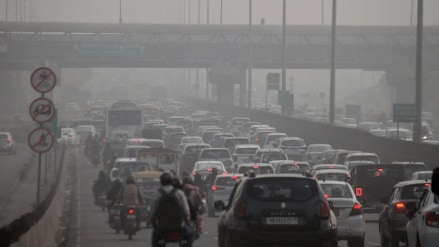The day after Diwali, Delhi woke up under a thick layer of smog, with air quality dropping to the ‘very poor’ category. The average AQI stood at 346 at 5:30 am on Tuesday, raising serious health concerns across the National Capital Region (NCR).
Delhi AQI remains ‘very poor’ after Diwali
The drop in air quality came after the Supreme Court allowed the use of green firecrackers during the festival. Most parts of the city remained in the red zone, creating hazardous conditions for residents. On Monday night at 10 pm, 36 out of 38 monitoring stations reported pollution levels in the red zone, warning very poor to severe air quality across Delhi.
#WATCH | Visuals from Akshardham temple as GRAP-2 invoked in Delhi.
— ANI (@ANI) October 21, 2025
The Air Quality Index (AQI) around Akshardham was recorded at 358, in the 'Very Poor' category, in Delhi this morning as per the Central Pollution Control Board (CPCB). pic.twitter.com/6JxECL9uPe
The worst-hit areas, according to the Central Pollution Control Board (CPCB), were:
- Dwarka: 417 (Severe)
- Ashok Vihar: 404 (Severe)
- Wazirpur: 423 (Severe)
- Anand Vihar: 404 (Severe)
According to the SAMEER app by the Central Pollution Control Board (CPCB) pollution levels across Delhi were extremely in some regions. The AQI in Wazirpur was the highest at 408, In Shadipur the AQI stood at 393, Punjabi Bagh at 375, RK Puram at 369, and Vivek Vihar at 367. Other areas also reported very poor air quality. Rohini at 367, Sonia Vihar at 359, North Campus DU at 352, Pusa at 346, Okhla Phase-2 at 345, Patparganj at 339, and Sirifort at 310.
#WATCH | Visuals from the India Gate as GRAP-2 invoked in Delhi.
— ANI (@ANI) October 21, 2025
The Air Quality Index (AQI) around the India Gate was recorded at 342, in the 'Severe' category, in Delhi this morning as per the Central Pollution Control Board (CPCB). pic.twitter.com/ZUwDCWpdT8
Narela had an AQI of 354, Najafgarh at 334. Mundka at 357, Mandir Marg at 325, Major Dhyan Chand National Stadium at 358, and Lodhi Road at 334. JLN Stadium reported 317, whereas Jahangirpuri’s pollution level rose with an AQI of 404. Central areas like ITO and Dilshad Garden recorded 345 and 346, respectively. In western and southern parts, Dwarka Sector-8 was at 333 and Mathura Road at 341. Bawana was one of the most polluted areas with 418, while Anand Vihar recorded 352.
Other areas recorded AQI in the “very poor” category, with the graph showing a dramatic rise in pollution levels after the festival.
The Central Pollution Control Board (CPCB) classifies the Air Quality Index (AQI) into six categories based on pollution levels. An AQI between 0 and 50 is considered good, while 51 to 100 is under satisfactory. Levels from 101 to 200 are moderate, and 201 to 300 are categorised as poor. When the AQI rises between 301 and 400, it is labelled as very poor, and level 401 to 500 indicate severe air pollution. Currently Delhi is Delhi is dealing with ‘severe’ category.
AQI- NCR
- Noida: Overall AQI – 324
- Sector 125: 326
- Sector 62: 307
- Sector 1: 322
- Sector 116: 340
- Gurugram: Overall AQI – 338
- Gwal Pahari: 347
- Sector 51: 346
- Vikas Sadan: 320
- Ghaziabad: Overall AQI – 326
- Indirapuram: 329
- Loni: 329
- Vasundhara: 351
Stage II GRAP activated
On Sunday, the Commission for Air Quality Management (CAQM) activated Stage II of the Graded Response Action Plan (GRAP) across Delhi-NCR. A review by the GRAP sub-committee is scheduled on Saturday alongside pollution forecasts from the India Meteorological Department (IMD) and the Indian Institute of Tropical Meteorology (IITM).
